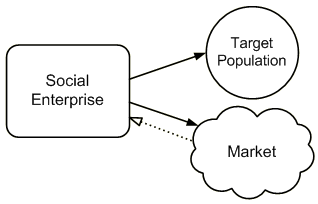 The service subsidization model of social enterprise sells products or services to an external market and uses the income it generates to fund its social programs.
The service subsidization model of social enterprise sells products or services to an external market and uses the income it generates to fund its social programs.
The service subsidization model is usually integrated: business activities and social programs overlap, sharing costs, assets, operations, income and often program attributes. Although the service subsidization model is employed primarily as a financing mechanism--the business mandate is separate from its social mission--the business activities may enlarge or enhance the organization's mission.
Nonprofits that implement service subsidization social enterprises operate many different types of businesses, however, most leverage their tangible assets (building, land, or equipment) or intangible assets (methodology, know-how, relationships, or brand) as the basis of their enterprise activities. Commercialization of core social services leads to enterprise activities that are close in nature to the organization's social programs and may enhance the mission; whereas leveraging physical assets to sell to the public may result in an enterprise that is very different from the organization's social programs. In financial terms the business benefits from leveraging and cost sharing relationships, and provides a stream of unrestricted revenue to "subsidize" or wholly fund one or more social services. Service subsidization is one of the most common types of social enterprises because it can be applied to virtually any nonprofit. The service subsidization model may conceivably grow into an organizational support model if it becomes profitable enough to throw off revenue to the parent organization.
Service subsidization model social enterprises can be any type of business. Those that leverage intangible assets such as expertise, propriety content or methodologies, or exclusive relationships tend toward service businesses that commercialize these assets: consulting, counseling, logistics, employment training or marketing. Those that leverage tangible assets such as buildings, equipment, land, employees, computers, etc. may launch any number of enterprises that utilize infrastructure and capital assets: leasing, property management, product-based retail businesses; copying, transportation or printing services, etc.
Theoretical example: a senior service organization has two social enterprises that generate revenue to subsidize its social programs serving frail indigent seniors. The organization's "eldercare business" commercializes case management services it renders free of charge to its clients. This social enterprise sells "premium eldercare" services, using the organization's expertise in nursing, therapy, and elder wellness in markets where either seniors (or their adult children) have the financial means to pay full fee, or are insured by a company that covers the service. In this case, the enterprise enhances the organization's mission by reaching a larger number of seniors, though not identified as the organization's clients. The organization's second enterprise leverages its 10 passenger van that carries clients on outings, to doctors' appointments, and shopping. The organization leases the vans at night to another nonprofit organization that works to reduce drunk driving accidents by contracting with bars and driving intoxicated customers home after last call. Though the second enterprise provides a social purpose, it is >a href="seum">unrelated to the mission of the senior-services parent organization. The two businesses combined generate 45% of the organization's budget, covering a large portion of its program costs.
ANCA, an example of Service Subsidization Model
Associacao Nacional de Cooperacao Agricola (ANCA) works in areas of Brazil where illiteracy rates are as high as 80% of the population. This education nonprofit provides literacy training and educational services to children, adults, and community activists.
While operating its programs, ANCA recognized a gap in the education market for pertinent leadership and organizing resources for the community activists it serves. In response to this need, ANCA developed training and educational materials for labor movement leaders, and found there was also high demand for these products outside their target population. ANCA saw an opportunity to sell its materials and generate supplemental income for its literacy programs. Thus, ANCA created a social enterprise, Editora Expressao Popular (Popular Expression Press), a publisher and clearinghouse for educational materials for nonprofit leaders and community activists.
Editora Expressao Popular sells periodicals, audiotapes, and publications within Brazil and export markets. The social enterprise enlarges ANCA's mission beyond teaching literacy to also facilitating social change. Editora Expressao Popular is integrated into ANCA as a division of the organization. In 2002 the enterprise sold 7,000 books, up from 4,500 the year before. Income is used to cover start up and operating costs of the press, and to subsidize programs aimed at ANCA's clients overcoming illiteracy.
